Apple Announces 5nm A14 SoC - Meagre Upgrades, Or Just Less Power Hungry?
by Andrei Frumusanu on September 15, 2020 4:30 PM EST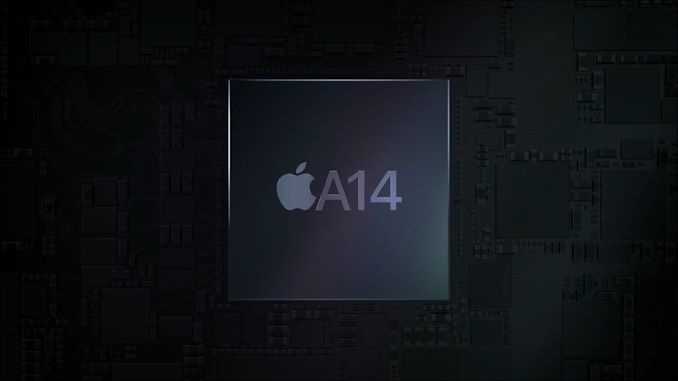
Amongst the new iPad and Watch devices released today, Apple made news in releasing the new A14 SoC chip. Apple’s newest generation silicon design is noteworthy in that is the industry’s first commercial chip to be manufactured on a 5nm process node, marking this the first of a new generation of designs that are expected to significantly push the envelope in the semiconductor space.
Apple’s event disclosures this year were a bit confusing as the company was comparing the new A14 metrics against the A12, given that’s what the previous generation iPad Air had been using until now – we’ll need to add some proper context behind the figures to extrapolate what this means.
On the CPU side of things, Apple is using new generation large performance cores as well as new small power efficient cores, but remains in a 2+4 configuration. Apple here claims a 40% performance boost on the part of the CPUs, although the company doesn’t specify exactly what this metric refers to – is it single-threaded performance? Is it multi-threaded performance? Is it for the large or the small cores?
What we do know though is that it’s in reference to the A12 chipset, and the A13 already had claimed a 20% boost over that generation. Simple arithmetic thus dictates that the A14 would be roughly 16% faster than the A13 if Apple’s performance metric measurements are consistent between generations.
On the GPU side, we also see a similar calculation as Apple claims a 30% performance boost compared to the A12 generation thanks to the new 4-core GPU in the A14. Normalising this against the A13 this would mean only an 8.3% performance boost which is actually quite meagre.
In other areas, Apple is boasting more significant performance jumps such as the new 16-core neural engine which now sports up to 11TOPs inferencing throughput, which is over double the 5TOPs of the A12 and 83% more than the estimated 6TOPs of the A13 neural engine.
Apple does advertise a new image signal processor amongst new features of the SoC, but otherwise the performance metrics (aside from the neural engine) seem rather conservative given the fact that the new chip is boasting 11.8 billion transistors, a 38% generational increase over the A13’s 8.5bn figures.
The one explanation and theory I have is that Apple might have finally pulled back on their excessive peak power draw at the maximum performance states of the CPUs and GPUs, and thus peak performance wouldn’t have seen such a large jump this generation, but favour more sustainable thermal figures.
Apple’s A12 and A13 chips were large performance upgrades both on the side of the CPU and GPU, however one criticism I had made of the company’s designs is that they both increased the power draw beyond what was usually sustainable in a mobile thermal envelope. This meant that while the designs had amazing peak performance figures, the chips were unable to sustain them for prolonged periods beyond 2-3 minutes. Keeping that in mind, the devices throttled to performance levels that were still ahead of the competition, leaving Apple in a leadership position in terms of efficiency.
What speaks against such a theory is that Apple made no mention at all of concrete power or power efficiency improvements this generation, which is rather very unusual given they’ve traditionally always made a remark on this aspect of the new A-series designs.
We’ll just have to wait and see if this is indicative of the actual products not having improved in this regard, of it’s just an omission and side-effect of the new more streamlined presentation style of the event.
Whatever the performance and efficiency figures are, what Apple can boast about is having the industry’s first ever 5nm silicon design. The new TSMC-fabricated A14 thus represents the cutting-edge of semiconductor technology today, and Apple made sure to mention this during the presentation.
Related Reading:
- The Apple iPhone 11, 11 Pro & 11 Pro Max Review: Performance, Battery, & Camera Elevated
- The Samsung Galaxy S20+, S20 Ultra Exynos & Snapdragon Review: Megalomania Devices
- TSMC Expects 5nm to be 11% of 2020 Wafer Production (sub 16nm)
- ‘Better Yield on 5nm than 7nm’: TSMC Update on Defect Rates for N5


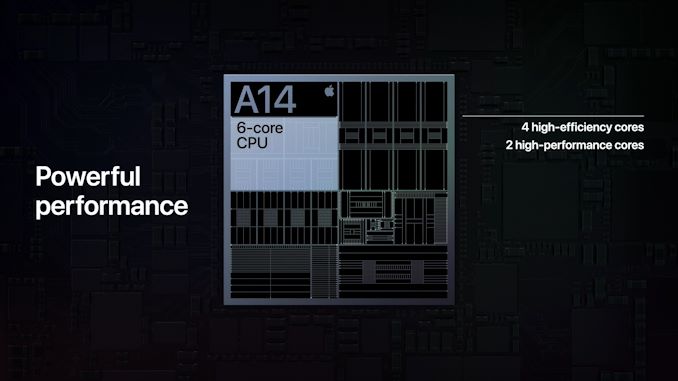
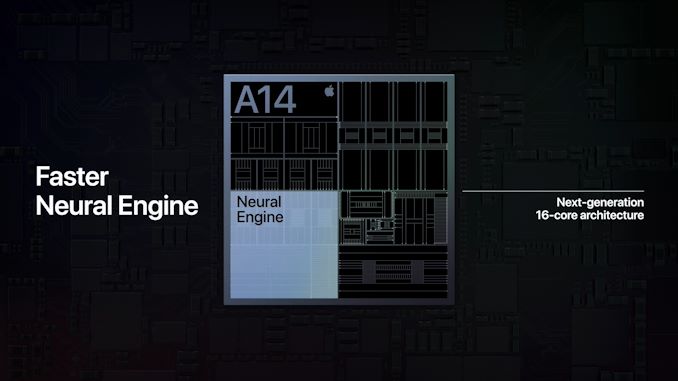
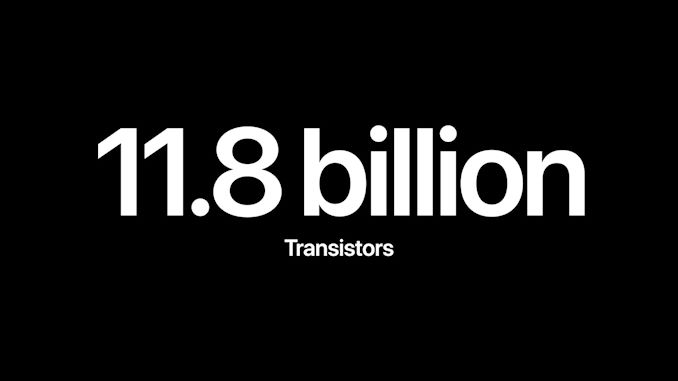
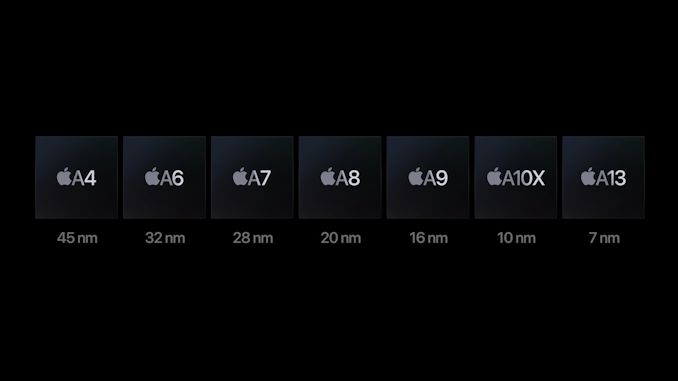








127 Comments
View All Comments
dontlistentome - Thursday, September 17, 2020 - link
Could limiting the peak power here be a way to put distance between this and the A14X or whatever it will be in the Mac? That way they can chuck some extra cores and extra power/cooling at that and have clear space between this on single and multi thread?Kurosaki - Thursday, September 17, 2020 - link
When is the 3080 review coming up AT?! I'm waiting! :DJu1iet - Thursday, September 17, 2020 - link
What about protecting from Meltdown and Spectre attacks? They're cheating the CPUs branch predictors. Are these new CPUs that are even richer in machine learning and AI features are safe now?jeffbui - Friday, September 18, 2020 - link
I'm hoping Apple used the initial production of 5nm chips for a smaller run of iPad Airs with some logic disabled. Otherwise, the A14 is rather disappointing.TouchdownTom9 - Friday, September 18, 2020 - link
I am really shocked to hear that this chip seems to have very limited improvements based on face value. Granted we need to see the chip in person and having the iPhone version will allow a better comparison, but the year Apple plans to start taking their chip lineup to the entire product stack, and they make little to no improvements beyond a die shink? Given they have made such major strides in this sector the last 5 years, I think this is pretty shocking. Perhaps we see a full 30-50%+ improvement in battery life, but I wouldn't bank on it.will_meig - Saturday, September 19, 2020 - link
The A14 is about 1,6 times faster than the A13. Not 16%.According to Apple, the A14 is twice as fast as the A12. And the A13 is 20% faster than the A12.
A12: 100%
A13: 120%
A14: 200%
120 x 1,66... = 200
tipoo - Monday, September 21, 2020 - link
Well your math is off on the basis that it's not twice as fast as the A12, their own numbers are 40% better CPU, 30% better GPU, and machine learning was all they said was doubled.adonishong - Sunday, September 20, 2020 - link
NVidia make use of RT-cores as ray-tracing computing unit and convolution network computing also. I have a theory, APPLE is targeting ray-tracing also ...high3r - Monday, September 21, 2020 - link
Could it be that this A14 is a clocked lower than those of iPhone 12?huangcjz - Monday, September 21, 2020 - link
When there's a difference in clock-speeds, the iPad version is usually clocked higher then the iPhone version, as iPads have a larger surface area and volume for heat dissipation than iPhones do.